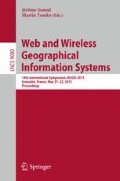Abstract
Landmarks are crucial elements in how people understand and communicate about space. In wayfinding they provide references that are preferred and easier to follow than distances or street names alone. Thus, the inclusion of landmarks into navigation services is a long-held goal, but its implementation has largely failed so far. To a large part this is due to significant difficulties in obtaining a sufficient data set of landmark candidates. In this paper, we introduce a mobile application, which enables a user-generated collection of landmarks. Employing a photo-based interface, the application calculates and ranks potential landmark candidates based on the current visible area and presents them to the user, who then may choose the intended one. We use OpenStreetMap as data source; the app allows tagging OSM objects as potential landmarks. Integrating users into the landmark selection process keeps data requirements low, while a simple interface lowers the burden on the users.
Access this chapter
Tax calculation will be finalised at checkout
Purchases are for personal use only
Preview
Unable to display preview. Download preview PDF.
References
Bauer, C.: On the (in-) accuracy of GPS measures of smartphones: A study of running tracking applications. Studies 3, 9 (2013)
Beeharee, A.K., Steed, A.: A natural wayfinding exploiting photos in pedestrian navigation systems. In: Proceedings of the 8th Conference on Human-Computer Interaction with Mobile Devices and Services, MobileHCI 2006, pp. 81–88. ACM, New York (2006)
Blum, J.R., Greencorn, D.G., Cooperstock, J.R.: Smartphone sensor reliability for augmented reality applications. In: Zheng, K., Li, M., Jiang, H. (eds.) MobiQuitous 2012. LNICST, vol. 120, pp. 127–138. Springer, Heidelberg (2013)
Crandall, D.J., Backstrom, L., Huttenlocher, D., Kleinberg, J.: Mapping the world’s photos. In: Proceedings of the 18th International Conference on World Wide Web, pp. 761–770. ACM, New York (2009)
Duckham, M., Winter, S., Robinson, M.: Including landmarks in routing instructions. Journal of Location Based Services 4(1), 28–52 (2010)
Ghasemi, M., Richter, K.F., Winter, S.: Landmarks in OSM, State of the Map 2011 (2011)
Goodchild, M.F.: Citizens as sensors: The world of volunteered geography. GeoJournal 69(4), 211–221 (2007)
Haklay, M.: How good is volunteered geographical information? A comparative study of OpenStreetMap and Ordnance Survey datasets. Environment and Planning B 37(4), 682 (2010)
Lomas, N.: Android still growing market share by winning first time smartphone users. http://techcrunch.com/2014/05/06/android-still-growing-market-share-by-winning-first-time-smartphoneusers/ (retrieved on: July 23, 2014)
Lynch, K.: The Image of the City. The MIT Press, Cambridge (1960)
May, A.J., Ross, T., Bayer, S.H., Tarkiainen, M.J.: Pedestrian navigation aids: Information requirements and design implications. Personal and Ubiquitous Computing 7(6), 331–338 (2003)
Modsching, M., Kramer, R., ten Hagen, K.: Field trial on GPS accuracy in a medium size city: the influence of built-up. In: 3rd Workshop on Positioning, Navigation and Communication, pp. 209–218. Hannover, Germany (2006)
Nothegger, C., Winter, S., Raubal, M.: Selection of salient features for route directions. Spatial Cognition & Computation 4(2), 113–136 (2004)
Papadopoulos, S., Zigkolis, C., Kompatsiaris, Y., Vakali, A.: Cluster-based landmark and event detection on tagged photo collections. IEEE Multimedia 18(1), 52–63 (2010)
Presson, C.C., Montello, D.R.: Points of reference in spatial cognition: Stalking the elusive landmark. British Journal of Developmental Psychology 6, 378–381 (1988)
Raubal, M., Winter, S.: Enriching wayfinding instructions with local landmarks. In: Egenhofer, M., Mark, D.M. (eds.) GIScience 2002. LNCS, vol. 2478, pp. 243–259. Springer, Heidelberg (2002)
Richter, K.F.: Prospects and challenges of landmarks in navigation services. In: Raubal, M., Mark, D.M., Frank, A.U. (eds.) Cognitive and Linguistic Aspects of Geographic Space - New Perspectives on Geographic Information Research. Lecture Notes in Geoinformation and Cartography, pp. 83–97. Springer, Heidelberg (2013)
Richter, K.F., Winter, S.: Harvesting user-generated content for semantic spatial information: the case of landmarks in OpenStreetMap. In: Proceedings of the Spatial Sciences & Surveying Biennial Conference, Wellington, NZ (2011)
Richter, K.F., Winter, S.: Landmarks – GIScience for Intelligent Services. Springer, Cham (2014)
Siegel, A.W., White, S.H.: The development of spatial representations of large-scale environments. In: Reese, H. (ed.) Advances in Child Development and Behaviour, pp. 9–55. Academic Press, New York (1975)
Sorrows, M.E., Hirtle, S.C.: The nature of landmarks for real and electronic spaces. In: Freksa, C., Mark, D.M. (eds.) COSIT 1999. LNCS, vol. 1661, pp. 37–50. Springer, Heidelberg (1999)
Tezuka, T., Tanaka, K.: Landmark extraction: a web mining approach. In: Cohn, A.G., Mark, D.M. (eds.) COSIT 2005. LNCS, vol. 3693, pp. 379–396. Springer, Heidelberg (2005)
Tomko, M.: Case study – assessing spatial distribution of web resources for navigation services. In: Proceedings of the 4th International Workshop on Web and Wireless Geographical Information Systems, pp. 90–104 (2004)
Vinson, N.G.: Design guidelines for landmarks to support navigation in virtual environments. In: Proceedings of the SIGCHI Conference on Human Factors in Computing Systems, pp. 278–285. ACM, New York (1999)
Author information
Authors and Affiliations
Corresponding author
Editor information
Editors and Affiliations
Rights and permissions
Copyright information
© 2015 Springer International Publishing Switzerland
About this paper
Cite this paper
Wolfensberger, M., Richter, KF. (2015). A Mobile Application for a User-Generated Collection of Landmarks. In: Gensel, J., Tomko, M. (eds) Web and Wireless Geographical Information Systems. W2GIS 2015. Lecture Notes in Computer Science(), vol 9080. Springer, Cham. https://doi.org/10.1007/978-3-319-18251-3_1
Download citation
DOI: https://doi.org/10.1007/978-3-319-18251-3_1
Published:
Publisher Name: Springer, Cham
Print ISBN: 978-3-319-18250-6
Online ISBN: 978-3-319-18251-3
eBook Packages: Computer ScienceComputer Science (R0)

